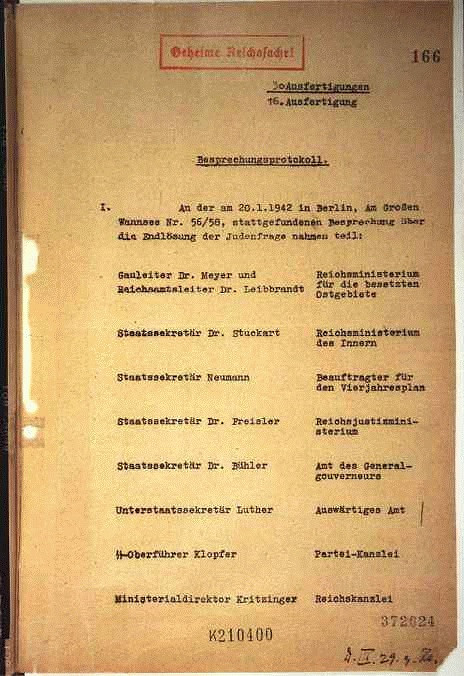- News
- Events
- Oneg Shabbat
- Collections
- Research
- Exhibitions
- Education
- Publishing Department
- Genealogy
- About the Institute
- Bookstore

In 1914 a pharmaceutical factory-owner, Ernest Marlier, decided to invest his earned money into an elegant villa with a garden on the outskirts of Berlin. The estate in Am Großen Wannsee street (later Große Seestraße) was designed by Paul O. A. Baumgarten. Marlier did not enjoy his white villa for long — in 1921, he sold it to a company called Norddeutsche Grundstücks Aktiengesellschaft. Sixteen years later, the house passed into the hands of a member the company board, merchant and supporter of far-right politics Friedrich Minoux. However, the villa did not bring him happiness — in 1940 he was arrested in charge with embezzling assets of a Berlin gasworks and he was put in prison. The house was sold to Nordhav foundation, founded by Chief of the Security Police (Sicherheitspolizei), SS-Gruppenführer Reinhard Heydrich. It served as holiday home for members of the SS. In this way, the villa in Am Großen Wannsee 56/58 became a guest house for high-ranking officers of the SD, the Gestapo and the Kripo. Also, commanders of special task forces (Einsatzkommando) spent their vacation there.

The villa was not only a holiday but also a conference centre. Therefore, there is nothing unusual in the fact that fifteen representatives of the SS, the NSDAP and various ministries gathered there at Heydrich’s invitation. On 20th January, 1942 at noon, in the dining room a meeting that was to be remembered as conference in Wannsee began. The invited guests included, among others, Heydrich, the chief of SS Race and Settlement Main Office Otto Hofmann, head of the Gestapo SS-Gruppenführer Heinrich Müller, deputy of Governor-General of occupied Poland’s territory Hans Frank, dr Josef Bühler, head of the section for „Jewish affairs” at Reich Main Security Office (RSHA) Adolf Eichmann as well as head of the Gestapo and Sipo in Ryga Rudolf Lange, who as a member of Einsatzgruppen was involved into the extermination of the Jews in Latvia. As it was expressed in the protocol written by Eichmann, the conference was held in order to establish „the line of action”. At the beginning of the meeting, Heydrich announced that Adolf Hitler had authorized him to make preparations to „the final solution of the Jewish question”, meaning the deportation of the Jews to the East. The man at the table assured that the offices and departments represented by them were going to cooperate fully — so the decision was made and only technical details needed to be arranged. In the minutes we read: “During the course of the Final Solution, the Jews will be deployed under appropriate supervision at a suitable form of labor deployment in the East. In large labor columns, separated by gender, able-bodied Jews will be brought to those regions to build roads, whereby a large number will doubtlessly be lost through natural reduction. Any final remnant that survives will doubtless consist of the elements most capable of resistance. They must be dealt with appropriately, since, representing the fruit of natural selection, they are to be regarded as the core of a new Jewish revival (what history teaches us).”
During the meeting other issues were raised — much time was devoted to the matter of „residents” (spouses from mixed-marriages, their children and grandchildren) and the order of „evacuations”. Deputy Governor dr Bühler suggested beginning it from the territory of the General Government as „the problem with transportation is not complicated there. (...) The Jews ought to be removed from the territory of the General Government as soon as possible, because it it there that a Jew is dangerous as a potential epidemic carrier.” Finally, it was emphasized that efforts should me made „not to cause alarm among the population”.
The meeting lasted 90 minutes. Those present were rather not aware of its historical meaning. The minutes form the conference were made in thirty copies. In 1947, among the documents of the Reich Ministry of Foreign Affairs, an American prosecutor, Robert Kempner, found copy no. 16, belonging to Undersecretary of the Ministry of Foreign Affairs Martin Luther.
After the war, the villa in Wannsee served as a place for school trips. In 1992, on the 50th anniversary of the conference, the Memorial was opened there.